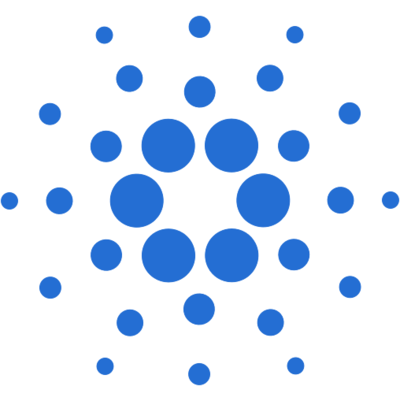
Layered blockchain for smart contract and dapp development
ADA price live chart

Download Cardano wallet app
Store & Transfer ADA safely
Monitor your ADA balance in USD
Receive ADA in BNB network
Send Cardano by mobile phone number with 0% fee
ADA wallet mobile app for iOS and Android
Cardano basics
Ada
Infrastructure
Cardano is an open-source, smart-contract platform that aims to provide multiple features through layered design. Its modularization will eventually allow for network delegation, sidechains, and light client data structures. Cardano uses a version of Proof-of-Stake (PoS) called Ouroboros to secure the network and manage the block production process. The network features a native token called ADA that gives stakers a claim on new issuance in proportion to their holdings and allows users to pay for transactions.
Cardano token type
ADA
Native
Payments, Vote
Cardano history and first price
Crowdsale
Cardano distributed vouchers for 25.9 billion ADA in a public token sale from September 2015 to January 2017. Participants could redeem the vouchers for actual ADA through Cardano’s native Daedalus wallet. The three entities supporting Cardano’s development received 5.2 billion ADA following the mining of Cardano’s genesis block. Their allocation was as follows:
- 2.46 billion ADA were allocated to IOHK which voluntarily adopted the following vesting schedule for its Ada: A third of IOHK’s ADA holdings were immediately available to IOHK. A third was made available on June 1st of 2018. The final third of IOHK’s Ada will be made available on June 1st of 2019
- 2.07 billion ADA were allocated to Emurgo.
- 0.648 billion ADA were allocated to the Cardano Foundation
Cardano is an open-source blockchain originating from peer-reviewed academic research. Cardano does not have a single published white paper but is developed from a collection of academic papers. Cardano sees itself as a “third-generation” protocol, improving on Bitcoin and Ethereum as the first and second generations, respectively. Cardano is named after an Italian Renaissance mathematician, Gerolamo Cardano, and its native currency ADA is named after Ada Lovelace, a 19th-century mathematician sometimes referenced as the first computer programmer.
Cardano is backed by three entities: IOHK, The Cardano Foundation, and Emurgo. IOHK is a blockchain research and development company founded by Charles Hoskinson and Jeremy Wood that is contracted to work on Cardano from 2015 through 2020. The Cardano Foundation is a non-profit organization focused on core development and ecosystem growth for Cardano. Emurgo is a Japanese venture capital firm.
Cardano's full launch will consist of five phases: Byron, Shelley, Goguen, Basho, and Voltaire. The Byron era arrived in September 2017 with the mainnet launch of the Cardano blockchain. During this phase, the chain operated as a federated network that only supported ADA transactions. The next phase, Shelley, launched in July 2020, bringing Cardano's proposed Ouroboros Proas Proof-of-Stake (PoS) protocol to life. It's now in the process of rolling out its third phase, Goguen, which will add support for smart contracts and native token issuance. Cardano development teams, IOHK and Emurgo, are researching and building the network's remaining phases, Basho and Voltaire, in parallel with Goguen.
The Goguen era will add smart contract functionality, giving developers the ability to build decentralized applications (dApps) on Cardano. DApp development will occur through Cardano's purpose-built smart contract language, Plutus, which makes use of the functional programming language Haskell. Goguen will also introduce Marlowe, a domain-specific language (DSL) for financial contracts built on Plutus. Marlowe and Plutus combined will enable developers to create Cardano-based tokens, such as native fungible or non-fungible tokens or the tokenization of external digital or physical assets (e.g., equity, commodities, real estates, etc.).
The Basho era will aim to optimize the network for scalability and interoperability. The goal is to improve the underlying performance of Cardano to better support growth and adoption for applications that require high transaction volumes.
Two of the primary developments proposed for the Bash era are sidechains and parallel accounting styles. Sidechains are new blockchains (like shard chains) that interoperate with the main chain. They can help off-load work from this base layer to increase the overall capacity of the network (scalability through parallel computation). While Cardano uses a UTXO model, sidechains will also have the ability to support account-based models. By having parallel accounting styles, Cardano might be able to interoperate with external networks more easily or support new kinds of uses cases.
The Voltaire era will introduce Cardano's proposed on-chain governance and treasury system. Participants will be able to use their staked ADA to voting on the future direction of the network.
Upon the launch of Voltaire, protocol improvement proposals will originate from community participants instead of solely through the management of IOHK and Emurgo. Token holders, either through direct staking or a delegation system, will then be able to vote on which proposals the network should implement. Voltaire will also see the addition of a treasury system, whereby a fraction of all transaction fees will be pooled to provide funds for development activities undertaken following the voting process.
The Byron era marked the first iteration of the Cardano network. It allowed users to buy, sell, and transaction its native cryptocurrency, ADA, across the protocol. The Byron chain ran on a purpose-built consensus layer, called Ouroboro Genesis, which operated as a federated network with the majority of the node managed by the Cardano Foundation. Therefore, any block rewards generated during this initial phase were burned (no inflation during Byron).
The Byron era also saw the delivery of the Daedalus wallet, IOHK's official desktop wallet for ADA, as well as Yoroi, a light wallet built by Emurgo for quick transactions and day-to-day use.
Shelley will introduce the Cardano's proposed Proof-of-Stake (PoS) consensus layer, enabling users to contribute to the transaction validation process either directly or via delegation, in exchange for staking rewards. The upgrade also marks a notable step forward on the path towards decentralization as the current mainnet operated as a federated network managed primarily by the Cardano Foundation.
The a href=" "full rollout of Shelley/a could take a month to reach completion. Cardano plans to release a Shelley mainnet candidate chain around Jun. 23 before releasing the code to mainnet on the Jun. 30 target date. The official hard fork that will activate Shelley’s changes could arrive on Jul. 29, which would give network participants enough time to upgrade their nodes and wallets. According to the roadmap, Cardano will begin paying out staking rewards around Aug. 18.
Cardano technology explained
The Cardano blockchain has two layers: a settlement layer and a computation layer. The Cardano Settlement Layer (CSL) serves to settle transactions made by peers in the network with ADA, Cardano’s native currency. The Cardano Computation Layer (CCL) is optimized to support smart contracts and decentralized applications.
Cardano developers chose a layered protocol to increase the network’s capacity for protocol changes and soft fork implementations. Cardano is developed in Haskell and Cardano smart contracts are created in Plutus, another programming language that allows for building stricter contracts.




Cardano supply limit
Inflationary
Decreasing Issuance
Yes
45000000000
Cardano caps the supply of ADA at 45 billion. The current ADA supply is roughly 31 billion, which leaves a remaining 14 billion for network incentives. Cardano incentives compensate for the network’s decrease in monetary expansion. Incentives increase as network use increases.
Cardano consensus
Proof-of-Stake
Ouroboros Proof-of-Stake
0.33 min
Cardano will use a Proof-of-Stake (PoS) consensus mechanism called Ouroboros once it reaches the "Shelley" era. Ouroboros consensus aims for improved network security and modularized design. Cardano’s modularization allows for network delegation, sidechains, and light client data structures.
Ouroboros design Ouroboros consensus is determined by slot leaders who are elected by token holders with a sufficient stake in the network. Slot leaders operate in epochs to listen for and confirm transactions to produce blocks, which are then approved by input endorsers. A Cardano input endorser is the second set of stakeholders that verifies transactions included in blocks. Cardano believes this design is scalable since the network can increase the number of slots per epoch and run multiple epochs across the network simultaneously.
Cardano governance
Upcoming
IOHK and the Cardano Foundation currently develop and implement any Cardano protocol updates. This off-chain governance model will continue until the network reaches the "Voltaire" era. At that point, ADA holders and stake pool operators will be able to vote on protocol improvement proposals. The off-chain process of developing and submitted code changes will remain even after the launch of Voltaire. Cardano's on-chain governance will simply determine whether the proposed change gets implemented or not.
Store Cardano with Cropty cryptocurrency wallet by 3 simple steps:
- Download the app from the Apple AppStore or Google Play, or open your browser wallet.
- Create your Cropty wallet account with Face ID or Touch ID security options.
- Transfer ADA from external wallet.
Receive Cardano to your Cropty wallet by QR-code, phone number, e-mail and nickname:
- Download the app from the Apple AppStore or Google Play, or open your browser wallet.
- Create your Cropty wallet account, set up a nickname.
- Click ‘Receive’ and follow the instructions.
You can transfer your Cardano holdings and store it safely with Cropty wallet. Cropty secures safety of your holdings through various verification options like using password, authenticator app, Face ID, Touch ID and backup codes. You can be sure no one can get access to you Cardano holding except you.
Start investing in Cardano with Cropty cryptocurrency wallet by 3 simple steps:
- Download the app from the Apple AppStore or Google Play, or open your browser wallet.
- Create your Cropty wallet account, set your authentication settings.
- Transfer ADA from external wallet.
The Cropty wallet provides the most convenient application for storing and transfering Cardano. Cropty targets to become one the best crypto wallets for Android and iOS in 2025. Cropty provides convenient application and secure custodial services, built for crypto beginners, as well as for crypto-savvies.
You can receive Cardano donations instantly with Cropty wallet. Download Android or iOS app or open the web version, sign up, click ‘Receive’ and follow simple instructions. Share your address with someone who wants to donate you in crypto.
You can receive Cardano donations instantly with Cropty wallet. Download Android or iOS app or open the web version, sign up, click ‘Receive’ and follow simple instructions. Share your address with someone who wants to donate you in crypto.
You can send Cardano instantly without fee in the Cropty wallet. Download Android or iOS app or open the web version, sign up, click ‘Send’, choose ‘Send via e-mail, phone number or nickname’ and follow simple instructions.
- Sign up to Cardano wallet.
- Top up your balance with Cardano.
- Store, trade or deposit your Cardano.
- Get Cardano deposit interest directly to your Cropty wallet.









